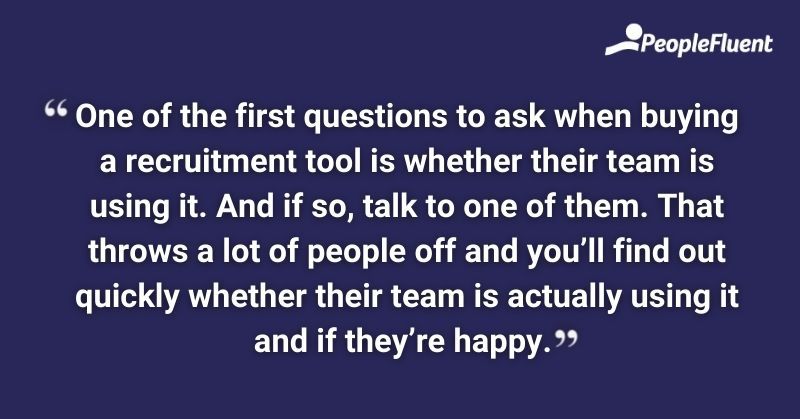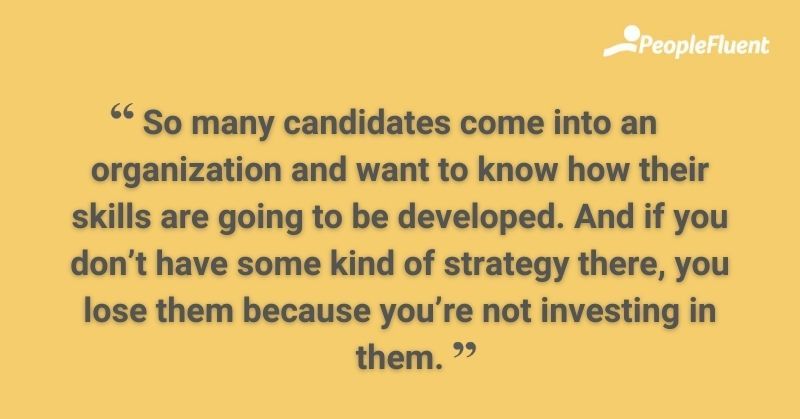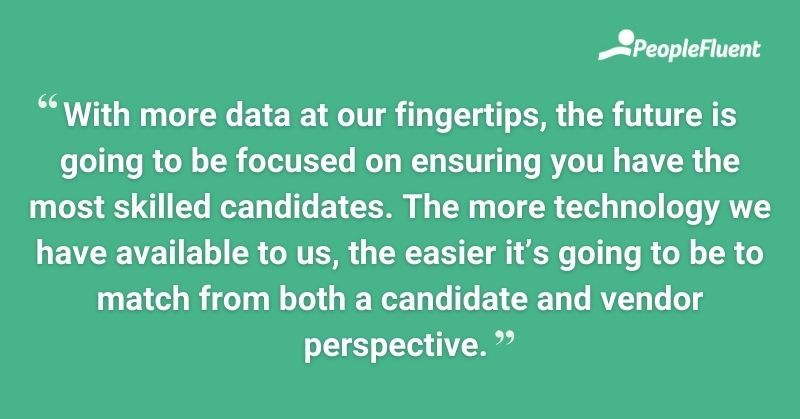Published: Aug 18, 2021Time to read: 6mins Category: Insights
Recruiting for the Needs of Today and the Demands of Tomorrow: A Q&A With PeopleFluent’s Stephen Bruce
Recruitment is a rapidly changing landscape. With advancements in technology, the number of recruiting tools available, and the blending of learning with all other facets of business, it’s no surprise that many HR and recruitment pros are left wondering what’s next. Read insights from PeopleFluent’s Managing Director, Stephen Bruce, on the changing landscape of recruitment, what to prioritize as part of your strategy, and what the future of recruitment looks like.
Stephen Bruce, PeopleFluent’s Managing Director, sat down with William Tincup from Recruiting Daily’s Use Case Podcast. During their 25-minute discussion, they talked about challenges the recruitment industry faces today, priorities that organizations should be aware of when formulating their strategy, and forecasts for the future.
In this blog post, we explore some of Stephen’s insights about the importance of creating and maintaining a positive employee experience, despite the changing landscape and the most important components to include in your recruitment tool.
YOU MIGHT ALSO LIKE | ‘5 Steps to Transform Your Talent Pipeline’
What Features Should You Look for in a Recruitment Tool?
A recruiting tool needs to be easy to use, provide a good user experience, and be intuitive. It should have only the features recruiters need and want at the times they need and want them. Otherwise, you risk feature bloat—if you just keep adding applications, nobody’s going to use them.
It’s important to look at how recruiters use the tool and drive greater value for the organization. But we also need to consider how the recruiter gets value. One of the biggest features to consider should be that you can access marketing functionality such as reporting, analytics, and nurture campaigns from within the product. The ability to bypass logging into separate applications such as CRMs, emails, and texting applications can help to streamline processes and make for a more holistic hiring experience.
You should also be mindful about the experience your candidates will have. You need to consider elements like how many clicks it takes for a candidate to apply, how can easy it is to manage the process, and to have the ability to communicate with customers, like texting, and so forth. All of these features will save time and make for a better user experience.
One of the first questions to ask when buying a recruitment tool is whether their team is using it. And if so, talk to one of them. That throws a lot of people off and you’ll find out quickly whether their team is actually using it and if they’re happy.

KEEP READING | ‘17 Questions to Get the Most out of a Recruiting Software Demo’
Why Is Having a Strategy so Important in Recruitment?
Having a solid recruiting strategy is crucial. It shows that you’re concerned about doing great recruiting instead of just focusing on the administrative processes of running the function.
When we think about a strategy, we need to think about how we validate skills rather than simply focusing on matching scores. If all we’re doing is matching candidates’ resumes that are built off the same workforce intelligence data that the vendors are matching to, then we’re just matching like for like. And there’s no value in that.
That’s why you need to think less about how you attract and identify candidates—which continues to be a challenge in recruiting—and more about how you validate and qualify the skills you already have. With more access to data and workforce intelligence information, it’s going to become much easier to match skills from both a candidate and vendor perspective. Instead, you should focus your efforts on evaluating the quality of hires over all of the integration and communication. This is why automation will become more important.
KEEP READING | ‘6 Strategies for Attracting Top Talent’
How Do You Measure Success in Recruitment?
Success is about leveraging and reshaping talent acquisition and being able to reflect it for customers. It’s about taking all of these compelling applications and being able to use those in such a way where it really does drive back to that experience for our employees. Success is about taking the best of existing processes and rethinking them for customers in the future to drive greater value.
What’s the Most Important Consideration When Focusing on Candidates?
Employee experience matters. Employees join an organization to advance, learn, and grow. They don’t care about the capabilities of a recruiting tool; only what’s happening in the front end. So many candidates come into an organization and want to know how their skills are going to be developed. And if you don’t have some kind of strategy there, you lose them because you’re not investing in them—you don’t have them on a path. You’re not investing in making them the best version of themselves while they’re there.
When we hire someone, the most important consideration is to make that experience as positive and seamless for the candidate as possible, starting with onboarding. We need to stop thinking in silos between recruitment and learning and focus on what it is that makes the experience so positive. If it’s been a terrible experience, you need to look at how you can improve on that.

HANDPICKED FOR YOU | ‘Employee Experience: How to Manage Before Day One… and Beyond’
What Does the Future Hold for the Recruitment Industry?
Recruiters are increasingly focused on thinking about skills, advanced matching, AI, and automation—that’s the future of the industry. At PeopleFluent, we have those capabilities in our recruiting and talent mobility products today. The interesting questions are ‘Where is it going to go?’ and ‘What will it mean for the future of recruiting and talent?’.
It’s a question of how do we take the best of our processes now and rethink them for the future. There’s a phenomenal concept around ‘people matter most’. With more data at our fingertips, the future is going to be focused on ensuring you have the most skilled candidates. The more technology we have available to us, the easier it’s going to be to match from both a candidate and vendor perspective.
This is what we’re looking at today and where automation will play a big role. With automation, recruiters can get into more dynamic conversations in evaluating the quality of the hire versus all of the integration and communication and texting, and other things to identify and get them into the process.

RELATED READING TO DOWNLOAD TODAY | ‘How to Create a Strong Recruiting Program (Regardless of Your Organization Size!)’
Final Thoughts
Recruitment is a fast-changing environment, so it’s important, moving forward, to keep people at the heart of our processes. This will be of even greater importance in the future as we look to use technology to facilitate our hiring strategy.
Discover How Recruiting Lets You Find the Right People—Fast!
PeopleFluent helps you fill critical roles with the right people and the right skillsets on a global scale. At the same time, it helps you build your employer brand and sharpen your competitive edge.